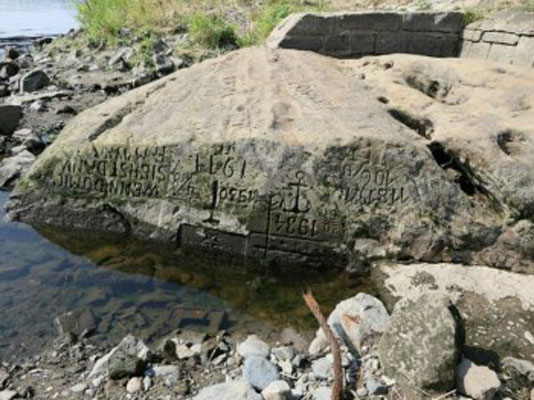Milieuzaken.org
feiten, getallen en opinies
Nederland
Volgens promovendus Aline te Linde zal Nederland heel wat vaker worden geteisterd door droogte dan door overstromingen. De kans op overstroming schat ze op eenmaal in de 1250 jaar en de kans op droogte op eens in de 20 jaar, oplopend tot om het jaar tegen 2050. Ze berekende de schade door de droogte in 2003. Toen werden in de Europesche Unie een derde van de oppervlakte en 100 miljoen mensen getroffen, waarvan 50.000 overleden. De economische schade voor scheepvaart, landbouw, drinkwater, industrie en natuur bedroeg € 8,7 miljard (bron: FD, 30-5-2009 n.a.v. het congres "Bessensap").
Hoe bepaal je nou het aantal doden door een droogte- of andere weer-periode ? Wellicht door een tijdelijke opleving van het gemiddelde, ver boven de natuurlijke variabiliteit over vele jaren ? Medici hebben op het overlijdens-formulier wel allerlei vakjes met medische oorzaken zoals hartaanval, verstikking etc, maar geen hokje "droogte" of "klimaat".
Gezegde: Het maken van voorspellingen is moeilijk, vooral waar het de toekomst betreft.
Ik vind het altijd knap als mensen 50 jaar vooruit kunnen denken. Terug denken lijkt al weer veel makkelijker. De afgelopen 1250 jaar is ons land door nogal heel wat overstromingen geteisterd, waaronder de heftige St. Elisabethvloed in 1421, die 10 à 100.000 doden zou hebben veroorzaakt. Zie hier voor een overzicht van ca. 50 overstromingen in ons land in de laatste 1250 jaar ! Na de grote overstromingsramp in 1953 zijn we echter wel het gigantische waterverdedigingswerk het "Deltaplan" gaan uitvoeren, die ons land sindsdien redelijk goed heeft beschermd, zoals bv. tijdens de grote storm "De Allerheiligenvloed van 2006". Er zijn echter doemdenkers die scenario's schetsen waarin Nederland meer last van nattigheid dan van droogte heeft.
Literatuur:
- Geurts, Harry, (oud persvoorlichter KNMI), Het weer nader verklaard: droogte door de eeuwen heen, Het Weer, z.j.
Engeland
London had lain under an exceptional drought since November 1665, and the wooden buildings were tinder-dry after the long hot summer of 1666. That was, of course, the year of the Great Fire of London, which swept through London between the 2nd and 6th of September. But they did not call it a Climate Emergency in those days! (Bron: Paul Homewood's blog Not a Lot of People Know That, 2-9-2019).
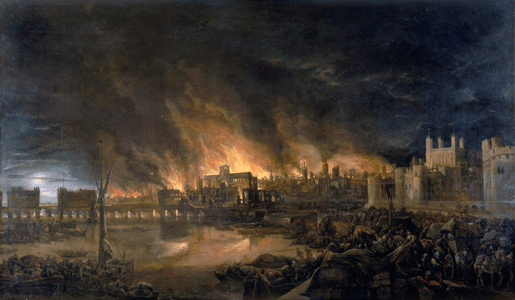
klik op her schilderij voor een vergroting
|
|
The Great Fire of London, depicted by an unknown painter, as it would have appeared from a boat in the vicinity of Tower Wharf on the evening of Tuesday, 4 September 1666.
To the left is London Bridge; to the right, the Tower of London. St. Paul's Cathedral is in the distance, surrounded by the tallest flames. |
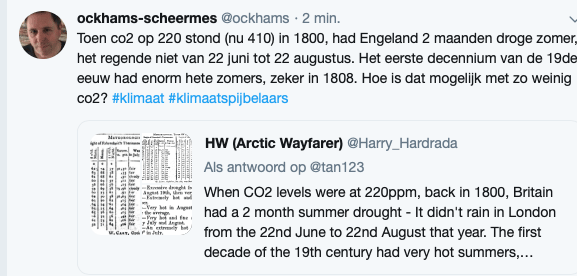
Egypte
The Epoch Times - August 19, 2012 (bron: crystalinks.com/egyptnews.html)
Was Ancient Egypt Wiped Out by a Mega-Drought?
Analysis of deep sediments around the Nile River in Egypt has shown a massive drought 4,200 years ago contributed to the end of Egypt's pyramid-building era, according to a new U.S. study. A team of researchers looked at fossilized pollen and microscopic charcoal in a sediment core spanning 7,000 years of history, and compared changes with archaeological and historical records.
“The study geologically demonstrates that when deciphering past climates, pollen and other micro-organisms, such as charcoal, can augment or verify written or archaeological records—or they can serve as the record itself if other information doesn’t exist or is not continuous,” explained study co-author Benjamin Horton at the University of Pennsylvania in a press release.
The team used charcoal as an indicator of drought-associated fires, predicting a decline in wetland pollen and an increase in charcoal during arid conditions.
They found four such events occurred between 3,000 and 6,000 years ago, in particular a dramatic global drought around 4,200 years ago that caused famines, affecting ancient Egypt and probably other Mediterranean cultures.
“Our pollen record appears very sensitive to the decrease in precipitation that occurred in the mega-drought of 4,200 years ago,” said study co-author Christopher Bernhardt at the U.S. Geological Survey (USGS) in the release.
“The vegetation response lasted much longer compared with other geologic proxy records of this drought, possibly indicating a sustained effect on delta and Nile basin vegetation.”
Two other significant droughts were evident—one around 5,000 years ago and the other around 3,000 years ago. The records mention the older drought occurring when Upper and Lower Egypt were unified, while the more recent one happened in the eastern Mediterranean with famines in the Babylonian and Syrian Kingdoms.
“Even the mighty builders of the ancient pyramids, more than 4,000 years ago, fell victim when they were unable to respond to a changing climate,” said USGS Director Marcia McNutt in the release.
“This study illustrates that water availability was the climate-change Achilles’ heel then for Egypt, as it may well be now, for a planet topping 7 billion thirsty people.”
The findings were published in the journal Geology last month.
Tsjechië
Bij het droogvallen van rivieren worden zgn. "hongerstenen" gegraveerd, soms met slechts een jaartal, soms met een navrante tekst, zoals: "Als je me ziet, huil dan".
A "hunger stone" exposed by the low level of water in the Elbe River is seen in Decin, Czech Republic, on Thursday. The low level of water caused by the recent drought has exposed the stones on the riverbed. (Petr David Josek/AP).
"Over a dozen of the hunger stones, chosen to record low water levels, can now be seen in and near the northern Czech town of Decin near the German border," the AP writes.
Op onderstaande steen kun je o.a. de jaartallen 1615, 1811, 1842, 1868, en 1921 zien.
Niemand die toen op de gedachte kwam dat dat "onze schuld" was vanwege een te hoge hoge CO2-uitstoot. Natuurlijk was men zich destijds ook wel sterk bewust van de Zondeval en 's mensens zondige gedragingen die de toorn God's zouden wekken, van de Wrekende God die de mensheid kon straffen. |
|
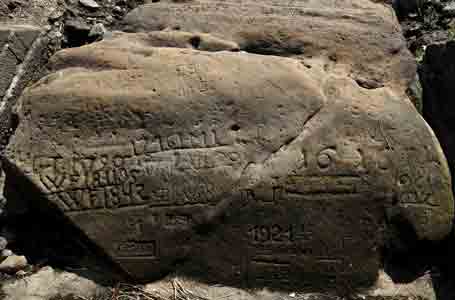 klik op de foto voor een vergroting klik op de foto voor een vergroting
|
| Bron: hier gevonden, in een zomer van 2018, die in heel Europa grote droogte bracht. |
In augustus 2022 wordt de Rijn weer slecht bevaarbaar voor o.a. de broodnodige steenkolenschepen van Rotterdam naar Duitsland en oost-europa, zo nodig wegens gebrek aan gas uit Rusland.
En wederom verschijnen foto's van hongerstenen in de media.
If anything, the fact that these stones have “reappeared” and have been uncovered multiple times in the past shows severe droughts have been common throughout European history.
There is no more evidence that human activities are the source of the present drought than existed when droughts and crop failures happened in the past, with some blamed on witches.
Although to the media a drought is a drought, in its 2021 Sixth Assessment report, the IPCC distinguishes four categories of drought: hydrological, meteorological, ecological, and agricultural.
The IPCC finds no evidence climate change has increased the number, duration, or intensity of hydrological or meteorological droughts, and it has only medium confidence it has “contributed to changes in agricultural and ecological droughts and has led to an increase in the overall affected land area.”
Even for ecological and agricultural droughts, the data is a mixed bag. The IPCC divides the world into 47 separate regions of study when analyzing drought trends, and its data suggests ecological and agricultural drought may have increased during the period of modest warming in 12 of those 47 regions.
However, in only two of those regions does the IPCC have even “medium confidence” for any human role in the observed increase.
For the remaining regions experiencing a possible increase in droughts, the IPCC has low confidence human activities have had any discernible impact.
As Climate Realism has noted in numerous past articles here, here, and here, for example, droughts around the world are weather events that may last a few years, but are hardly unprecedented in Earth’s history, even in Europe.
Concerning the message the hunger stones are sending, one must understand what they are and their history. Wikipedia describes hunger stones as:
…a type of hydrological landmark common in Central Europe. Hunger stones serve as famine memorials and warnings and were erected in Germany and in ethnic German settlements throughout Europe in the 15th through 19th centuries.
These stones were embedded into a river during droughts to mark the water level as a warning to future generations that they will have to endure famine-related hardships if the water sinks to this level again.
One certainly can’t cite the hunger stones to establish that the present drought is the worst in the past 500 years.
Photos of the hunger stones accompanying the Business Insider article show Europeans experienced droughts equal to or more severe than the present one in 1417, 1616, 1707, 1746, 1790, 1800, 1811, 1830, 1842, 1868, 1892, and 1893.
Verenigde Staten - USA
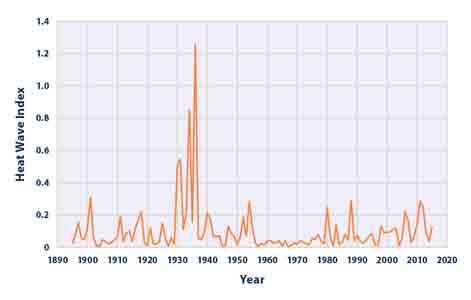 Klik op de grafiek voor een vergroting Klik op de grafiek voor een vergroting
|
|
This figure shows the annual values of the U.S. Heat Wave Index from 1895 to 2015. These data cover the contiguous 48 states. Interpretation: An index value of 0.2 (for example) could mean that 20 percent of the country experienced one heat wave, 10 percent of the country experienced two heat waves, or some other combination of frequency and area resulted in this value.
Bron: EPA-Environmental Protecton Agency, USA
Data source: Kunkel, 20166
Web update: August 2016
|
De zomers met de meeste hittegolven waren nadrukkelijk in de jaren 1930 e.v.
De EPA schrijft er het volgende over:
"Heat waves in the 1930s remain the most severe heat waves in the U.S. historical record (see Figure 1). The spike in Figure 1 reflects extreme, persistent heat waves in the Great Plains region during a period known as the “Dust Bowl.” Poor land use practices and many years of intense drought contributed to these heat waves by depleting soil moisture and reducing the moderating effects of evaporation."
Wereld
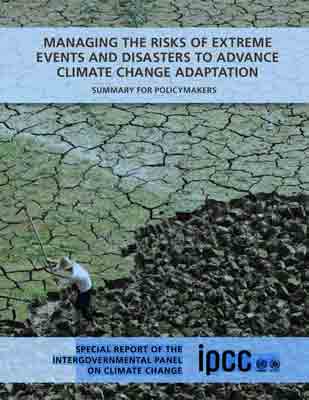 klik voor vergroting op de foto klik voor vergroting op de foto
|
|
In 2012 schreef het IPCC en speciaal rapport over extreem weer:
"Managing the risks of extreme events and disasters to advance climate change adaptation"
Zie hier de inhoudspagina. |
Hans Labohm schrijft hierover op climategate.nl van 21-4-2018: "Het IPCC heeft geen trends kunnen ontdekken in weersextremen en al helemaal geen verband met CO2."
In november 2018 legt Thierry Beaudet van Forum voor Democratie e.e.a. uit in de 2e kamer:
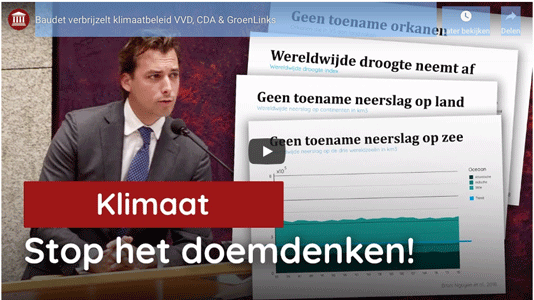 |
|
In november 2018 maakt Beaudet in de 2e-kamer beschouwingen wederom gehakt van de klimaatparagraaf van het Ministerie van Economische zaken en Klimaat, die ca. 2/3e van haar begroting wil gaan weggooien aan (dus niet) "doelmatig" klimaatbeleid, waar de Nederlandse economie die vele miljarden goed zou kunnen gebruiken om onze economie en/of ons welzijn te bevorderen. Bekijk en beluister zijn redevoering hier. |
Maar sinds jaar en dag zien velen in een paar jaren extreem weer, of zelfs bij heel wat kortere periodes extreem weer, al gauw een klimaatverandering optreden, even vergetend dat klimaat meestal wordt gedefinieerd als het gemiddelde weer over een periode van minstens 30 jaren.
Als U op het NOS-weer-journaal weer eens hoort zeggen dat de huidige weersextremen een teken zijn van klimaatverandering, denk dan even aan dit krantenbericht uit 1871: dus, geen nieuws onder de zon ! |
|
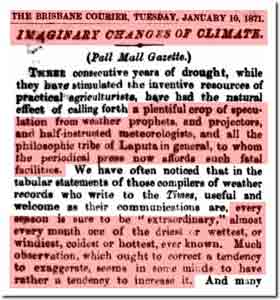
klik op de tekst voor een vergroting |
De vermeende invloed van jo-jo's op droogte
(Bron: Climategate .nl d.d. 21-9-2013, door Hajo Smit)
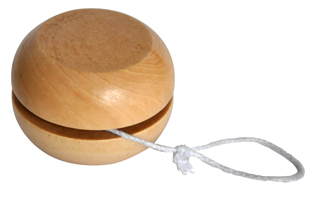 |
|
It’s the yoyo’s stupid! Heel erg leuk om naast het herkauwen van platgetreden sceptische waarheden als een koe (3 x beeldspraakwaarde) als klimaatblogger ook weer eens wat te leren. Dat is gisteravond gelukt! Wat lees ik namelijk in een prachtig epistel van Cal Thomas in de Washington Examiner:
Just how silly this is getting is an assertion by some activists that the current tensions in Syria might be linked to climate change. That’s not as harebrained as a newspaper report in January 1933, which said, “Yo-Yo Banned in Syria, Blamed for Drought by Moslems.” The Syrians of 1933 actually believed the up and down of a toy yo-yo affected the weather. If it went down and sprang right back up, rain. If it went down and didn’t spring up, drought. Police reportedly patrolled the streets, confiscating the toy. |
Kijken we op Wikipedia bij jojo zien we:
Volgens het Polygoon-journaal was er in 1932 een jojorage in Nederland. Jong en oud, iedereen speelde met de jojo. Later rond het jaar 1998 werd het jojoën ‘herontdekt’. Dit keer werden er zelfs op de kinderzenders speciale korte programma’s aan gewijd.
Bron: Climategate .nl d.d. 21-9-2013, door Hajo Smit |
Verdere literatuur:
- Buisman, J. (2011), Extreem Weer !, een canon van Weergaloze Winters & Zinderende Zomers, Hagel en Hozen, Stormen en Watersnoden, Uitg. Van Wijnen - Franeker, 576 p. met vele illustraties en tabellen in kleur, ISBN: 978 905 194 35 80.
- Geurts, Harry, (oud persvoorlichter KNMI), Het weer nader verklaard: droogte door de eeuwen heen, Het Weer, z.j.
Deze website is een activiteit van dr. Hugo H. van der Molen, Copyright 2007 e.v.
Mail ons uw commentaar, aanvullingenen en correcties !
en Facebook of Linkedin



